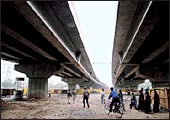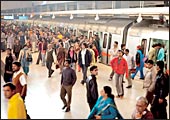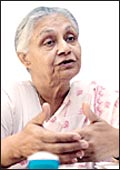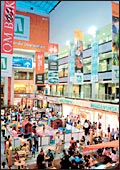 |
| On the fast track: The Metro has given
Delhi's image a boost |
 |
| Bridging the gap: Tech, hub Noida has
proved a worthy neighbour |
 |
| WIP but will get there: Work on the
expressway connecting Delhi and Gurgaon is behind schedule |
DELHI 3
For
people who aren't particularly sporty, Delhi's residents sure
are looking forward to the 2010 Commonwealth Games the city is
scheduled to host. "The 1982 Asian Games provided tremendous
fillip to the infrastructure of Delhi," says Rajan Bharti
Mittal, Joint Managing Director, Bharti Airtel Ltd. "The
2010 Commonwealth Games represent an opportunity for another round
of facelifts for the city." Mittal is merely echoing the
sentiments of the capital's estimated 16 million residents when
he says this; Delhi will become only the second Asian city after
Kuala Lumpur to host the games, and several agencies are expected
to spend over Rs 5,000 crore in upgrading the city's civic infrastructure
in preparation. Problems related to power, water, even roads (although
Delhi boasts the best in the country), will all be sorted out,
is the hopeful refrain. For, despite the obvious advantages it
enjoys from being India's capital and home to the Supreme Court
(it was a court decision that prompted all public transport on
the city's roads to move to CNG), Delhi has its share of problems.
The most pressing of these is power: the summer of this year saw
daily shortfalls reaching as high as 300-400 mw on some days.
Then, there is water (or the lack of it), and zoning. The last
continues to see the Delhi government, the central government,
and the Supreme Court locked in a battle over unauthorised commercial
use of land and buildings in residential areas. Despite all these,
Delhi is #3 on Business Today's ranking of the best cities for
business.
The Re-invention Of Delhi
In the mid-1990s, Delhi wasn't exactly a
great city for business (even in 2001, the city ranked #9 in this
magazine's survey). Both of its business districts, Nehru Place
and Connaught Circus, were heaving masses of humanity, creaking
at the seams, and ready to crumble; its roads, despite being the
best in the country even then, couldn't cope with the volume of
traffic (then, as now, Delhi had more vehicles on its roads than
the other three metros and Bangalore together); and, perhaps most
significantly, most of the old business houses based in the city
were either decaying or going through a painful process of reinvention
(and the new businesses, companies like Bharti, were yet to make
an impact).
| DELHI FACT FILE |
FOUNDED: 1060 A.D.
AREA: 1,483 sq. km (National Capital Territory)
POPULATION: 13.7 million*
ROAD LENGTH: 26,323 km
PUBLIC TRANSPORT: 25,705 buses
PEAK POLLUTION LEVELS: So2: 12.7 micro-gram/metre cube,
SPM^: 549.7 micro- gram/metre cube
INDUSTRIAL LOAD SHEDDING: 4-5 hours
RESIDENTIAL LOAD SHEDDING: 2-10 hours
POWER TARIFF: Rs 2.40-4.60 per unit (residential);
Rs 3.70-5.64 per unit (commercial)
PIPED WATER SUPPLY: 2-24 hours per day
COMMUTING TIME: 45 minutes to an hour from city centre
to the outskirts
COST OF DOMESTIC HELP: Rs 600 a month
COST OF PETROL: Rs 46.85/litre
COMMERCIAL REAL ESTATE RATES:
Rs 10,000-18,000/sq. ft
RESIDENTIAL REAL ESTATE RATES:
Rs 19,500-27,800/sq. ft
TELEDENSITY: 761 per 1,000 people
AVERAGE PER CAPITA WHITE COLLAR WAGES:
JUNIOR MANAGER: Rs 4-10 lakh per annum
MIDDLE MANAGER: Rs 8-20 lakh per annum
SENIOR MANAGER: Rs 16-30 lakh per annum
NUMBER OF MURDERS: 258 (till July 15, '06)
NUMBER OF TRAFFIC ACCIDENTS: 4,774 (till July 15, '06);
of these 969 were fatal
HEALTHCARE: 2.02 hospital beds per 1,000 people
CONSUMER PRICE INDEX: 120** |
Over the last few years, however, Delhi has
begun to benefit from events that were set in motion in the early-
and mid-1990s (and not always by the local administration): the
first was the emergence of Gurgaon and, to a lesser extent, Noida,
as worthy satellites; the second was the birth and rapid growth
of the Business Process Outsourcing industry (and the fact that
BPO-pioneer GE picked Gurgaon as its base); the third was the
Supreme Court's activism (especially in l'affaire CNG); the fourth
was the arrival (or comeback, in some cases) of businesses such
as Bharti, Ranbaxy, and BILT; and the last was the various infrastructure-related
initiatives undertaken by the various governments and government
agencies responsible for Delhi and the National Capital Region
(as the greater Delhi, Faridabad, Gurgaon, Noida, and Ghaziabad
area is known), including the city's famed Metro.
"In the last three to four years, Delhi
is probably the only city which has seen some serious augmentation
in facilities," says Sanjay Verma, Joint MD, Cushman and
Wakefield, a realty firm. The Delhi Metro (it started operations
on one stretch in 2002) is currently a 60-km network that is used
by half a million commuters every day. If all goes well, by 2010,
it will extend to Noida and be used by a million commuters every
day. Extensions to Gurgaon and Ghaziabad, which are also on the
anvil, will reach out to even more people. Already, Connaught
Circus, the terminal for all Metro lines, is witnessing significant
renewal. "The Delhi Metro has become the lifeline for the
city," gushes Ajay S. Shriram, Chairman and Senior MD, DCM
Shriram Consolidated Ltd. And the NCR boasts enough space, some
30,000 sq. km, to accommodate Delhi's grandiose expansion plans.
"Delhi's location gives it the capacity to grow and still
ensures the quality of its public spaces," says Dikshu C.
Kukreja, a Harvard-trained urban planner and Director, Architects,
C.P. Kukreja & Associates.
 |
| Well-connected: Delhi already has the
best roads in the country |
 |
| Rush hour: The Metro has eased traffic
woes with half-a-million commuters using it every day |
Indeed, Delhi, circa 2006, would appear to
have a lot going for it: it is the centre of government in a country
where the government still has a role in business; it is a cosmopolitan
city; it has some of the best schools and hospitals in the country;
and it has more than a fair share of reasonably well-maintained
public places. By some estimates, the green cover in the city
has increased from 151 sq. km in 2001 to 268 sq. km in 2003 and
325 sq. km today. "Although there is lesser requirement (for
government interaction) post liberalisation, access to ministries
is easier to co-ordinate from Delhi," says Mohit Burman,
Director, Balsara Home Products. "The quality of life (in
Delhi) is good," adds Dan Sandhu, Chairman, Vertex, a UK-headquartered
BPO, who came down to Delhi with an idea of spending 18 months
in the city (in 2002) and has since chosen to stay on.
Diversified, Not Risk-free
Most of India's best-known companies are
headquartered in Mumbai. However, the overwhelming business-culture
of India's commercial capital has to do with the world of finance.
India's two premier stock exchanges and three commodity exchanges
are based in the city. Bangalore is India's undisputed tech capital.
Delhi and the NCR, in contrast, boast a fairly diversified industrial
profile. Gurgaon is an auto-belt, BPO-belt, and MNC-belt, all
at once; Faridabad is home to several engineering industries;
Noida is North India's technology hub (but not exclusively that);
and, by virtue of the purchasing power of their citizens, Delhi
and Gurgaon are retail mini-Meccas. Add a dash of pharmaceuticals
and telecom, and the picture is complete. This range of industries,
explains Vertex's Sandhu, is a magnet for potential investors.
Interview with Sheila
Dixit, Chief Minister/Delhi
"Maybe We Could Have Achieved More" |
 In
seven years, Delhi chief minister Shiela Dixit has
seen it all: the highs of the Delhi Metro and the move to
CNG; and the lows of the perennial power crisis and the recent
controversy over demolitions. Dixit, who is quick to say that
Delhi is a far cry from being a truly world-class city, speaks
to Business Today about her plans for the city. Excerpts: In
seven years, Delhi chief minister Shiela Dixit has
seen it all: the highs of the Delhi Metro and the move to
CNG; and the lows of the perennial power crisis and the recent
controversy over demolitions. Dixit, who is quick to say that
Delhi is a far cry from being a truly world-class city, speaks
to Business Today about her plans for the city. Excerpts:
What are the constraints you face while trying to make
Delhi a world-class city?
The multiplicity of organisations dealing with Delhi is
a significant constraint.
Power has been one of the key issues for businesses
in Delhi. Do you think privatisation has been a success?
Sure, things could be better, but for a system which has
been vandalised for years, the situation is much better.
Transmission losses are now down to less than 1 per cent.
In 1999, the total demand for Delhi was 1,900 mw. It has
now risen to 3,800 mw. Hopefully, in the next two-three
years load-shedding should be a thing of the past.
Law and order is also a concern for prospective investors...
That is the perception. However, the police statistics
show the situation is not as bad as it is perceived to be.
The perception and the apprehensions of the citizens need
to be addressed.
The Supreme Court has taken objection to the Delhi
Laws (special provisions) 2006 putting one-year moratorium
against the removal of unauthorised construction?
I would not like to comment on the issue as it is sub judice.
However, one needs to remember that the city has grown tremendously.
What is your vision for Delhi?
Delhi should be a happy city. Why do people flock to cities
like Paris and London? There is so much to do.
Any disappointments/regrets in these last seven years?
Although much was done, maybe we could have achieved more.
|
Just as it is a magnet, in this part of the
country, for young educated migrants (and unskilled immigrants
of indeterminate age too) in search of the proverbial pot of gold.
"The quality of the workforce, the lifestyle offered by the
city, and the ease of attracting talent is a big, big advantage,
at least for the BPO industry," says Raman Roy, India's original
BPO entrepreneur (he was the first CEO of GECIS, now Genpact,
and later founded Spectramind which he sold to Wipro), who is
now onto his fourth BPO venture Quattro. Delhi is well connected
to the rest of the world and it is part of the famed Delhi-Agra-Jaipur
golden triangle that attracts tourists (this is a big plus even
for serious business travellers who invariably schedule a day
trip to Agra in their business itinerary).
 |
| Outsourcing hub: Gurgaon and Noida are
home to some of the big names in the BPO industry |
|
|
| Mall mania: The National Capital Region
has become a retail Mecca, a sign of the region's growing
prosperity |
The city's present, then, looks fine. If there
are fears over Delhi's future as a centre of business (and there
are), they have to do with issues related to its satellites, the
NCR, and the way in which the city itself is administered. Gurgaon
and Noida may have relieved Delhi's burden some, but both seem
to be emulating the capital in terms of city planning. Zoning
laws in Gurgaon, if any, would appear to be on paper only, with
malls, high-rise apartments, offices, low-rise villas, multiplexes,
even schools and hospitals, nudging each other. Issues related
to parking, power, water and mixed use of land, which Delhi ignored
to its own detriment, are now being ignored by the satellites.
The NCR Planning Board, established with the objective of ensuring
that an agency plans for the region as a whole, has ways to go.
The continuing trouble over water for Delhi's Sonia Vihar treatment
plant-the commissioning of the project has been delayed more than
once due to the uncertain water supplies from the up government-is
an example. Then, Delhi itself is administered by several organisations,
some of which do not even fall under the purview of the state
government. "The Delhi Development Authority is not under
the Delhi government and we do not have a representation in it,"
rues Chief Minister Shiela Dixit. The city's Master Plan dates
back to 2001 and is based on planning estimates of the late 80s.
"It lacks the three-dimensional planning for micro-character
of each zone that is the characteristic of world-class cities,"
says Kukreja. Dixit is hoping that the two committees-Omesh Saigal
Committee and Ashok Pradhan Committee-looking at reorientation
of the Delhi administration, and which are expected to table their
reports shortly, will come up with something concrete.
That would help. And if there is another
catalyst, apart from the Commonwealth Games, required, the city
has just got itself one. In cricket-mad India, it is set to host
the final of the Cricket World Cup 2011.
|










 In
seven years, Delhi chief minister Shiela Dixit has
seen it all: the highs of the Delhi Metro and the move to
CNG; and the lows of the perennial power crisis and the recent
controversy over demolitions. Dixit, who is quick to say that
Delhi is a far cry from being a truly world-class city, speaks
to Business Today about her plans for the city. Excerpts:
In
seven years, Delhi chief minister Shiela Dixit has
seen it all: the highs of the Delhi Metro and the move to
CNG; and the lows of the perennial power crisis and the recent
controversy over demolitions. Dixit, who is quick to say that
Delhi is a far cry from being a truly world-class city, speaks
to Business Today about her plans for the city. Excerpts:

